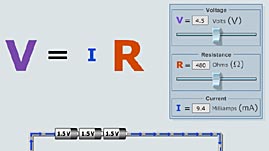Teachers' Domain - Digital Media for the Classroom and Professional Development
User: Preview

Source: PhET, Physics Education Techonolgy, University of Colorado
In this interactive simulation adapted from the University of Colorado's Physics Education Technology project, learn about the relationship between electric current, voltage, and resistance. Known as Ohm's law, this relationship can be described by the equation V = I x R. In this activity, you can adjust the voltage and resistance in a simple circuit to see how the current changes according to Ohm's law.
In an electric circuit, electric charges continuously travel though a closed loop. This flow of charges is known as electric current. A basic battery-powered electric circuit uses a battery to drive the current through a loop of wire.
The battery provides a difference in electrical potential energy, or a voltage difference, often simply referred to as voltage. You can think of it as a difference in pressure: high pressure at one end of the battery and low pressure at the other. In the same way that a difference in water pressure pushes water through a pipe, creating a flow of water, a difference in voltage pushes electric charge through the wire, creating a flow of current through the circuit. The greater the voltage, the greater the current.
When electric current flows through a material, it is likely to encounter resistance. Instead of traveling a direct path through the closed loop, charges may be scattered as they collide with the atoms of the material. Electrical resistance is a measure of how much the flow of electric charge is opposed in this way. The greater the resistance, the more difficult it is for current to flow.
In the nineteenth century, German physicist Georg Simon Ohm realized that there was a mathematical relationship between current, voltage, and resistance. He understood that electric current is directly proportional to voltage and inversely proportional to resistance. This relationship can be described by a simple equation, I= V/R, now known as Ohm's law. It is also commonly written as V = I x R, where:
V = voltage, the difference in electrical potential between the terminals of the voltage source (measured in volts);
I = current, the rate of flow of electric charge (measured in amperes); and
R = resistance, the measure of opposition to the flow of electric charge (measured in ohms).
Materials that obey Ohm\'s law are said to be ohmic. Almost all electronics contain ohmic devices called resistors, which are designed specifically to resist electric current. When designing electric circuits, engineers use resistors to establish specific values for voltage and current. For example, the light-emitting diode (LED) that is commonly found in electronics—such as that used to light up the numbers on some digital clocks—can be damaged if too much current runs through it. To make sure that the current reaching an LED is at a safe value, a resistor is connected in the circuit.
 Loading Standards
Loading Standards Teachers' Domain is proud to be a Pathways portal to the National Science Digital Library.
Teachers' Domain is proud to be a Pathways portal to the National Science Digital Library.
